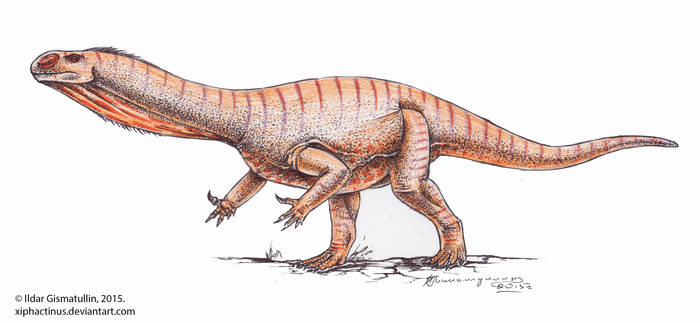Welcome to Aardonyx

Name Definition
Earth claw
Name Given By
Yates et al., 2010
Location
Elliot Formation of South Africa
Classification
Dinosauria, Saurischia, Sauropodomorpha, Anchisauria
Size
Estimated to be about 2 meters tall (6.5 ft) and 6 meters long (19.6 ft), about 453 kg (about 998.6 lbs)
Temporal Range
Hettangian - Sinemurian ages of the Early Jurassic, about 195 million years ago
Ecological niche
Mid-sized herbivore
Species/Sub Species
A. celestae
Diet
The partial skull remains indicate that it would have stripped off of foliage
Introduction
Aardonyx is a genus of basal sauropodomorph dinosaurs that lived in Africa during the Early Jurassic. Similar to some other creatures represented in the fossil record, Aardonyx represents a transitory form between the prosauropods and the much bulkier sauropods. These can be most easily observed in its legs, where there are adaptations for a slower but more stable and powerful method of locomotion, however Aardonyx was still habitually a bipedal animal. These changes along with the increasing quadrupedal locomotion that the sauropods utilized to bear their body weight would have allowed them to reach gargantuan sizes, more than any other kind of land animal. The genus is represented by partial vertebrae remains, ribs, partial remains of the shoulder girdle, fore and hind limbs, an ischium, a pubis, a partial skull, as well as the manus and pes (hand and foot). These remains were confirmed to be of two juveniles by counting the growth rings on the cortical bone structures, and while the exact nature of their death is currently uncertain, they were both found together with some bones scattered around. Because the bones were largely not disturbed, it is also possible that the two juveniles were washed and drowned in a flash flood and then were also deposited together. The fact that these two juveniles were also of the same age may indicate that they lived with each other and could have been of a much larger herd.
Besides the transitional evidence in the limbs, Aardonyx also shows a transition to the bulk-browsing habits of large sauropods. Aardonyx has a narrow and V-shaped jaw with a pointed symphysis (a symphysis is a complete fusion of bones), a plesiomorphic (a plesiomorphy is an ancestral trait in a group that is not unique to that group and cannot be used as a defining trait) trait seen in other basal sauropodomorphs. In sauropods, the jaws are broad and U-shaped which allowed sauropods to have a wider bite. Because of the absence of a lateral ridge in the back of the dentary, it is thought that Aardonyx did not possess any kinds of cheeks. The absence of fleshy cheeks is also seen in many sauropods and is thought to be an adaptation for bulk-browsing, as the absence of cheeks allow the sauropods to have a wider gape so they can consume more plants at once. The V-shaped jaws and the absence of cheeks is rather unusual for Aardonyx, as it was thought that the broader and U-shaped jaws evolved before the reduction and total loss of the cheeks in order for the sauropods to be able to bulk-browse, which is not the case in Aardonyx. The more derived sauropod Chinshakiangosaurus also has a typical U-shaped jaw for a sauropod, but still retains the fleshy cheeks seen in basal sauropodomorphs, which is the exact opposite of the situation seen in Aardonyx. This suggests that a cheekless mouth in sauropods may have evolved twice: the first time with Aardonyx, and the second time with sauropods more derived than Chinshakiangosaurus.
Sources:
- https://en.wikipedia.org/wiki/Aardonyx
- http://www.prehistoric-wildlife.com/species/a/aardonyx.html